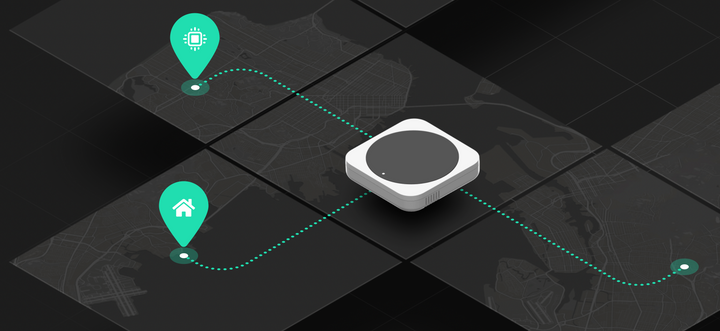LoRaWAN Connectivity: Build vs. Buy
You’re facing a major decision in your deployment process: whether to build your own LoRaWAN network or make use of the public network options that are available to you.

So, you did your research on the different connectivity options, weighed the pros and cons of NB-IoT, Wi-Fi, Sigfox and others, and you settled on LoRaWAN as the best option for your project. But now you’re facing another major decision in your deployment process: whether to build your own LoRaWAN network or make use of the public network options that are available to you.
As with most decisions in IoT, given the fact that there are no one-size-fits-all solutions, making this decision still requires the options to be carefully considered. The answer will ultimately depend on the characteristics of your project, what it intends to do, and the resources available to you.
» FREE TRIAL: Launch Your IoT Application To Market in Less Than 30 Days with Ubidots IoT Device Management Dashboard
In this article, we'll look at the build vs. buy question to give you the pros and cons of each one and explain what to consider when choosing the right option for your project.
Let’s begin with a rundown on LoRaWAN itself.
Context About LoRaWAN
LoRaWAN is a low-power, wide-area networking protocol that gives life to the world of the Internet of Things by providing bi-directional communication, end-to-end security, mobility, and localization services. It is built on top of the LoRa radio technology (the physical layer of the network), a modulation technique that encodes information on radio waves and works particularly well in the transmission of small packets of data.
Despite its steady growth, the technology is young, with three episodes that stand out in its history:
- Two French friends started developing LoRa for commercial purposes in 2009.
- In 2012, a proprietary MAC protocol called “LoRaMAC” was created to specify the message formats and security layers.
- In February 2015, the LoRa Alliance was founded and the networking protocol was renamed as “LoRaWAN.”
LoRaWAN Architecture
The LoRaWAN architecture consists of four parts:
Node: Devices equipped with sensors to collect data and LoRa transmitters to send that data to the gateways. Even though you can put together your own nodes, there are plenty of good ready-to-use devices such as the SenseCAP S210X series by Seeed Studio.
Gateway: Devices, such as RAKwireless’ WisGate Edge Lite 2, that are typically only in charge of forwarding the devices’ data to the server. They are equipped with a LoRa concentrator that allows them to receive information from the nodes. To communicate with the servers, gateways use higher bandwidth communication protocols like Wi-Fi or cellular.
Network server: It’s in charge of the management of gateways, the authorization of the sensors, and the bi-directional exchange of data between the sensors and the applications.
Application server: It’s the application layer of the architecture and, from there, things like uplink data decryption and decoding, downlink queuing, and downlink data encoding and encryption are handled.
In LoRaWAN, the end nodes “talk” to the gateways (not with other nodes). Gateways forward the data they receive from the nodes to the server, which removes duplicate data packets, verifies data integrity and performs security checks before sending the message to the application server. You can find a more detailed explanation of how LoRaWAN works in this article.
Benefits of LoRaWAN
It is no coincidence that LoRaWAN is among the most popular options for IoT connectivity considering the list of benefits that can be derived from its use. Aside from the low power demand and the long-range for which it is well-known, LoRaWAN also stands out for its support of bi-directional communication, which means that it’s possible to send messages to the end devices, a feature that facilitates control in industrial environments.
The list of benefits LoRaWAN brings to the table also includes its low cost, the capacity of its servers to handle millions of messages from thousands of gateways, its robust ecosystem, and for being accessible either publicly or privately.
And it’s precisely on that last point that we would like to focus on this post, because even when the possibility to use LoRaWAN with either a private or a public network is beneficial, deciding which to choose can be hard. So, let’s go over what both options bring to the table and compare their pros and cons.
Private LoRaWAN Networks (Build)
Thanks to the open nature of the LoRaWAN protocol, it is possible for anyone to set up their own network.
In general, a private network is that in which its elements (gateways and servers) are under the control of the user and are only accessed by the owner and whoever is granted permission by them. In short, these networks have one or few users, are usually small in scale and have their owners in control over them.
Depending on the scale of the network, compared to other technologies, deploying a LoRaWAN network isn’t that expensive. This is thanks to the fact that one gateway can handle thousands of end nodes and cover 10 km (6.2 mi.) or more, which is enough for most operations. With the price of indoor gateways starting at $70 dollars or less and server subscriptions at about $85 dollars a month for the basic plans, setting up a private network is not prohibitive.
These are the main steps to set up a private network:
- Deciding whether to pay for a server service or making a custom server.
- Getting the needed number of gateways.
- Deploying them on the desired spot.
- Declaring the sensors in the gateways.
- Creating the connections between the gateways and the data processing platform.
- Activating the devices.
The main perks of a private network come in the shape of the security and control they offer.
LoRaWAN is a secure protocol, but a deficient implementation can make it vulnerable. A private setup gives all the control to its owner, which can reduce the risk of eavesdropping or data breaches. This control goes beyond security, though, since any customization or change to the network (e.g., to increase its coverage) can be done and depends only on the owner and their resources.
Another two important benefits of a private setup are that, in some cases, this can be a cheaper option, since the subscription expenses of a public network can be quite steep if the number of devices using the network is high. The other benefit is the ability to guarantee optimal indoor coverage, thanks to the control the owner has on the deployment of the parts and their growth.
On the other hand, these are some of the disadvantages of a private setup:
- When it comes to expenses, it requires higher initial investment and recurrent maintenance costs.
- Correctly setting up and deploying all the parts of the network requires some technical knowledge.
Public LoRaWAN Networks (Buy)
Public LoRaWAN networks cover swaths of territory and are offered by either telecom companies or community-driven organizations that own the gateways and/or servers. Contrary to their private counterparts, public networks are used by multiple people and organizations.
Depending on the network provider, the fee to be paid for the subscription can depend on a fixed plan, the number of devices connected to the network, the amount of data transmitted over a certain period, or a combination of these factors.
Public networks come with the immediate advantage of providing parts of the network, like the gateways and the network servers, leaving you with fewer things to worry about.
Using them usually requires a few steps: paying for the subscription, registering the devices on the operator's platform, activating them, and retrieving the data generated by the sensors on the operator’s platform and forwarding it to another platform to process it (that last step is optional).
Depending on the country, there are multiple or no LoRaWAN public network operators, who offer different subscription plans and different densities of coverage.
As for the community networks, the case of The Things Network stands out as a great example of what the open nature of the protocol can enable: a growing, global network where thousands of people contribute to it. Another example in this category is Loriot, a company that offers free servers for you to connect your gateways and devices.
Here's a list of the benefits public networks offer:
- Their coverage is large, making it ideal for operations with scattered or moving devices.
- In line with the first point, a network run by an operator enables you to go beyond borders thanks to roaming.
- Since the infrastructure is already there, the initial costs are low.
Meanwhile, there are mainly five cons to the use of a public alternative. The main one is related to security. Even though the two parts of a network are more vulnerable to attacks —i.e., the devices and the communication between the network server and the app server— depending on the user in any type of LoRaWAN network, public networks are still a riskier option.
These are the remaining four disadvantages:
- Increasing the number of devices (and data) can result in expensive subscription bills.
- The available coverage may not be enough for indoor requirements or specific locations.
- Roaming may be costly.
- Potentially more unscheduled downtimes.
Hybrid
There’s another option in the build vs. buy question, and it is, simply, to opt for a combination of both. A hybrid approach can fill the gaps of coverage by allowing the user to access larger areas with a public network while still guaranteeing optimal indoor or location-specific connectivity with their own setup. It could also be a good economic strategy for some operations, where balancing the costs of the private and public networks might outperform their separate versions.
Comparison Table
» FREE TRIAL: Launch Your IoT Application To Market in Less Than 30 Days with Ubidots IoT Device Management Dashboard
Frequently Asked Questions
What is a private LoRaWAN Network?
It’s a network setup deployed, maintained, and used by a limited number of organizations or people. The gateways and network servers are privately owned and can be changed and improved at will.
What is a public LoRaWAN Network?
It’s a network setup that is run by an operator or a community that can be used by multiple organizations and people who, usually, pay a subscription fee. It’s the operator or community that decides what changes or improvements are made to the network.
What are the differences between both?
Private networks offer a higher degree of control, which usually translates into better coverage and security. Since they’re small in scale, a private network is a good option for an operation where the devices are concentrated and fixed. Setting up a private network requires higher initial expenses and recurring maintenance bills, but can be cheaper in the long run, especially if the number of nodes connected to it is high.
On the other hand, since public networks are already there, users just need to pay a subscription and register the devices to use them. They’re usually large in terms of coverage — this makes them good for moving and scattered devices, but not ideal for nodes that are indoor or in rural areas where coverage may be insufficient or nonexistent. The subscription model makes public networks a good option for small-scale operations since the prices usually depend on the number of nodes or the amount of data they generate — this, as can be guessed, becomes a disadvantage when the number of nodes increases.
How to build a private network?
The first step is to get the gateways and server. A server service can be paid recurrently, or a custom-made server can be set up — a third option is to use available public server services, like Loriot’s. After getting these parts, building a network requires the following steps:
- Deploying the gateways on the desired spot.
- Declaring the nodes in the gateways.
- Creating the connections between the gateways and the data processing platform.
- Activating the nodes.
Building a private network requires the proper knowledge so that the different parts coordinate and everything works correctly.
Which network providers are available?
There are 170 LoRaWAN operators globally, according to the LoRaWAN Alliance, which vary from country to country. There are two noteworthy options in the public network environment: The Things Network, an open, global, community-driven network, and Loriot, a LoRaWAN Network Server provider that offers a free public version of their service that is intended for proof of concept, academic research or LoRaWAN enthusiasts.


